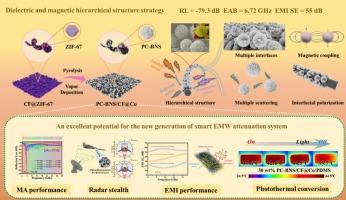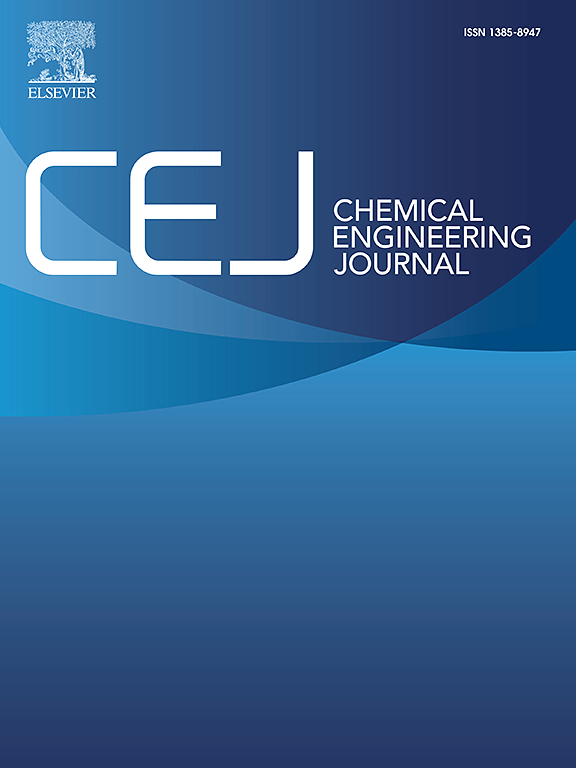Multifunctional pompon chrysanthemum-like boron nitride microsphere/carbon fiber@cobalt heterostructured composites toward highly-efficient microwave absorption and electromagnetic interference shielding
IF 13.2
1区 工程技术
Q1 ENGINEERING, CHEMICAL
引用次数: 0
Abstract
Effective Multifunction integration of multifunctional capabilities into microwave absorption (MA) materials is a future direction but remains significant challenges. Herein, a pompon chrysanthemum-like boron nitride microsphere/carbon fiber@metallic cobalt (PC-BNS/CF@Co) hierarchical structure is fabricated through an in-situ deposition of metallic Co and subsequent autocatalytic growth of PC-BNSs on the surfaces of CFs process. CFs are widely employed as fillers in electromagnetic materials, owing to their low density and high electrical conductivity. However, they suffer from impedance mismatch, resulting in weak MA absorption. The incorporation of metallic Co and PC-BNSs could simultaneously optimize the dielectric and magnetic properties of CFs, improving the impedance matching and thus significantly enhancing the MA absorption performance of CFs. Impressively, the absorber with only 5 wt% PC-BNS/CF@Co can achieve a minimum reflection loss of −79.3 dB and a wide absorption bandwidth of 6.72 GHz. And the simulation results also indicate the potential for radar stealth applications in both civil and military coatings. These results outperform most similar composites recently reported. Additionally, PC-BNS/CF@Co enhances the electromagnetic interference (EMI) shielding and photothermal conversion properties of polydimethylsiloxane (PDMS) films. Fascinatingly, the 30 wt% PC-BNS/CF@Co/PDMS film exhibits excellent EMI shielding efficiency of 55 dB through absorption-dominant EMI shielding mechanism. Additionally, it demonstrates remarkable photothermal conversion capability under simulated sunlight of 40 mW cm−2. The multifunctional PC-BNS/CF@Co hierarchical structure uniquely combines the high-efficient MA absorption, EMI shielding and thermal management capabilities, exhibiting promising potentials in the new generation of smart electromagnetic wave (EMW) attenuation systems.

多功能菊花绒球状氮化硼微球/碳fiber@cobalt异质结构复合材料用于高效微波吸收和电磁干扰屏蔽
将多种功能有效地集成到微波吸收材料中是未来的发展方向,但仍存在重大挑战。本文通过原位沉积金属Co,然后在碳纤维表面自催化生长PC-BNS,制备了一种菊花绒球状氮化硼微球/碳fiber@metallic钴(PC-BNS/CF@Co)分层结构。碳纤维具有密度小、导电性好等优点,被广泛应用于电磁材料的填料中。然而,它们的阻抗不匹配,导致弱毫安吸收。金属Co和pc - bns的掺入可以同时优化CFs的介电和磁性能,改善阻抗匹配,从而显著提高CFs的MA吸收性能。令人印象深刻的是,只有5 wt% PC-BNS/CF@Co的吸收器可以实现最小的反射损耗- 79.3 dB和6.72 GHz的宽吸收带宽。仿真结果还表明了该涂料在民用和军用涂料中雷达隐身应用的潜力。这些结果优于最近报道的大多数类似的复合材料。此外,PC-BNS/CF@Co增强了聚二甲基硅氧烷(PDMS)薄膜的电磁干扰(EMI)屏蔽和光热转换性能。令人着迷的是,30 wt%的PC-BNS/CF@Co/PDMS薄膜通过吸收主导的电磁干扰屏蔽机制,表现出55 dB的优异电磁干扰屏蔽效率。此外,在40 mW cm−2的模拟阳光下,它显示出显著的光热转换能力。多功能PC-BNS/CF@Co分层结构独特地结合了高效的MA吸收,EMI屏蔽和热管理能力,在新一代智能电磁波(EMW)衰减系统中显示出巨大的潜力。
本文章由计算机程序翻译,如有差异,请以英文原文为准。
求助全文
约1分钟内获得全文
求助全文
来源期刊

Chemical Engineering Journal
工程技术-工程:化工
CiteScore
21.70
自引率
9.30%
发文量
6781
审稿时长
2.4 months
期刊介绍:
The Chemical Engineering Journal is an international research journal that invites contributions of original and novel fundamental research. It aims to provide an international platform for presenting original fundamental research, interpretative reviews, and discussions on new developments in chemical engineering. The journal welcomes papers that describe novel theory and its practical application, as well as those that demonstrate the transfer of techniques from other disciplines. It also welcomes reports on carefully conducted experimental work that is soundly interpreted. The main focus of the journal is on original and rigorous research results that have broad significance. The Catalysis section within the Chemical Engineering Journal focuses specifically on Experimental and Theoretical studies in the fields of heterogeneous catalysis, molecular catalysis, and biocatalysis. These studies have industrial impact on various sectors such as chemicals, energy, materials, foods, healthcare, and environmental protection.
 求助内容:
求助内容: 应助结果提醒方式:
应助结果提醒方式:


